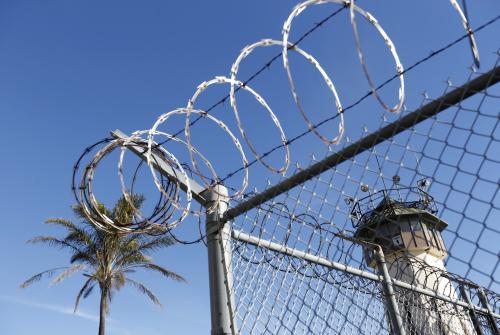About one third of all 30-year-old men who aren’t working are either in prison, in jail, or are unemployed ex-prisoners. Almost half of ex-prisoners have no reported earnings in the first several years after leaving prison; among those who do find work, half earn less than $10,090 a year or less than a full time job at minimum wage.
These are just a few of the sobering findings from a new study of ex-prisoners in the U.S. by myself and the Federal Reserve Board’s Nicholas Turner. Using unique administrative data, we find that the labor market struggles of ex-prisoners start well before their incarceration. Most grew up in deep poverty and many weren’t working—or were earning very little—before incarceration. A disproportionate share grew up in racially segregated neighborhoods where child poverty rates were high, most parents were unmarried, and few men were employed.
That such a large share of working-age men without jobs are also prisoners or former prisoners from deeply disadvantaged backgrounds has implications for the design of prisoner-focused subsidies. For instance, relaxing the burdensome requirements on subsidies targeted to ex-prisoners or replacing focused subsidies—like the Work Opportunity Tax Credit (WOTC)—with broad-based subsidies for low-skill, marginally employed individuals—like an expanded Earned Income Tax Credit (EITC) for childless workers—would expand eligibility for work-related subsidies and reach more of the intended recipients.
Our findings reinforce what other research has illustrated—that poverty, race, and incarceration are interconnected. By addressing the challenges facing children born into poverty, we could reduce incarceration rates and improve labor market outcomes. Given the strong relationship between childhood conditions and later incarceration, the best way to help ex-prisoners find good-paying jobs may be to turn our attention to the problems that start long before imprisonment. This could include focused policies that invest in children, fight racial discrimination and geographically concentrated poverty, and reform the criminal justice system.
Here are five findings from the new research:
1. Ex-prisoners fare poorly in the labor market. In the first full calendar year after their release, only 55 percent reported any earnings, with the median earnings being $10,090. Of those with earnings, 4 percent earned less than $500, 32 percent earned between $500 and $15,000, and only 20 percent earned more than $15,000.
2. But prisoners fared poorly in the labor market before they were incarcerated. Of the prisoners we studied, only 49 percent of prime-age men were employed two full calendar years prior to incarceration. Of those who were employed, their median earnings were only $6,250. Only 13 percent earned more than $15,000. Indeed in any given year in the decade prior to their incarceration, only about half of prisoners had any reported earnings.
3. Growing up in poverty dramatically increases the likelihood of incarceration. Boys who grew up in families in the bottom 10 percent of the income distribution were 20 times more likely to be in prison on a given day in their early 30s than children born in top ten percent of families. Almost one in ten children born to families in the bottom 10 percent were therefore incarcerated at age 30. At the extremes of the family income distribution, the differences are larger: Boys from the poorest families were 40 times more likely to end up in prison compared to boys from the richest families.
4. A third of men age 30 without any annual earnings are either incarcerated or unemployed former prisoners. Of the 17 percent of men age 30 that have no earnings in 2012, about 3.5 percent were in prison or jail and another 3 percent are former prisoners without work—combined, they make up more than a third of all non-working men age 30. Among men born to parents in the bottom half of the income distribution, the share of non-working men is closer to 50 percent. And these figures exclude any impairment to employment associated with having served time in jail (rather than prison) or from the 30 percent of felony convictions that do not result in incarceration. In short, the difficulties that many men face in the labor market, particularly low-income men seeking to move up the economic ladder, are closely related to their involvement in the criminal justice system.
5. The neighborhood you grow up in matters. Differences in incarceration rates can vary within cities by a factor of 30 between zip codes that are walking distance apart. Prisoners were disproportionately likely to have grown up in socially isolated and segregated neighborhoods with high rates of child poverty and in predominantly black or American Indian neighborhoods. In Los Angeles, for instance, the incarceration rate at age 30 of children growing up in neighborhoods in Westwood, Santa Monica, or Sierra Madre was essentially zero, whereas in neighborhoods in south LA or Compton the rate (of men and women combined) was close to 7 percent. In more rural states, like the Dakotas, Nebraska, Wyoming, or Idaho, while the overall incarceration rate is low, certain areas had high rates of incarceration. For instance, roughly 10 percent of all 30-year-old prisoners in Nebraska came from a single neighborhood in Omaha.
Here are the top 10 neighborhoods with the highest incarceration rates for men and women at 30-years old.
| City | Zip | Incarceration Rate | Child Poverty Rate | Percent Black | College Attendance |
|---|---|---|---|---|---|
| Nashville, Tennessee | 37208 | 14% | 42% | 93% | 30% |
| Portsmouth, Virginia | 23704 | 11% | 37% | 77% | 32% |
| Waco, Texas | 76707 | 11% | 35% | 34% | 24% |
| Cincinnati, Ohio | 45214 | 11% | 46% | 65% | 22% |
| Fort Myers, Florida | 33916 | 11% | 37% | 82% | 24% |
| Jacksonville, Florida | 32206 | 11% | 46% | 79% | 20% |
| Orlando, Florida | 32805 | 10% | 42% | 93% | 24% |
| Norfolk, Virginia | 23504 | 10% | 52% | 90% | 26% |
| Richmond, Virginia | 23222 | 10% | 27% | 80% | 29% |
| Tusla, Oklahoma | 74106 | 10% | 41% | 62% | 29% |
In our analysis, we used data on 2.9 million prisoners maintained by the Internal Revenue Service (IRS) and submitted by the Federal Bureau of Prisons and the heads of State prison agencies to facilitate tax audits and reduce refund fraud.
To learn more about the research or to download data and appendices, visit the full paper here.
The Brookings Institution is committed to quality, independence, and impact.
We are supported by a diverse array of funders. In line with our values and policies, each Brookings publication represents the sole views of its author(s).






Commentary
5 facts about prisoners and work, before and after incarceration
March 14, 2018